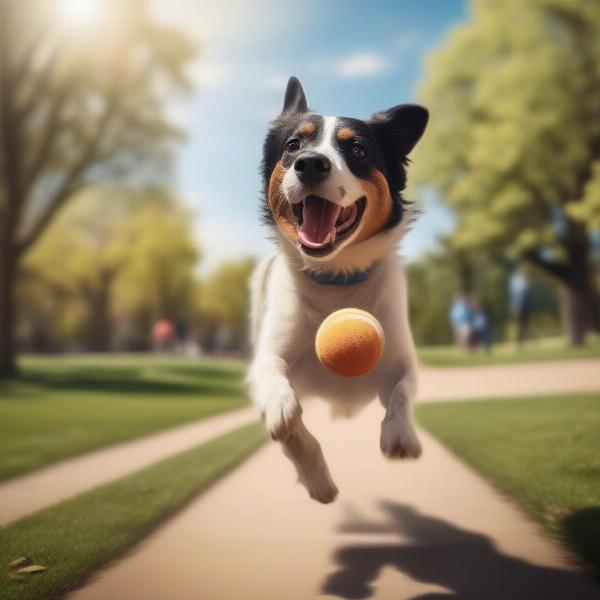A happy dog is a healthy dog, and a healthy dog is often a happy one. But what does it truly mean to have a happy dog, and how can we, as responsible owners, ensure our furry friends live their best lives? This guide delves into the core components of canine happiness, offering practical advice and insights to help you understand and meet your dog’s needs. From nutrition and exercise to training and affection, we’ll explore the key elements that contribute to a joyful, fulfilling life for your beloved companion.
Understanding Your Happy Dog’s Needs
Just like humans, dogs experience a range of emotions. While they might not express happiness with a smile, there are many telltale signs of a contented canine. A relaxed body posture, a wagging tail, playful bows, and soft, gentle eyes are all indicators of a dog at ease. Conversely, a tucked tail, hunched back, excessive panting, or whining can suggest discomfort or stress. Learning to interpret your dog’s unique body language is crucial to understanding their emotional state.
Providing for your dog’s basic needs is the foundation of happiness. This includes access to fresh water, a nutritious diet, regular exercise, a safe and comfortable environment, and plenty of love and attention.
Nutrition and a Happy Dog’s Diet
A balanced diet is essential for a happy and healthy dog. Choose high-quality happy dog food formulated to meet your dog’s specific needs, considering factors like age, breed, and activity level. Avoid overfeeding, which can lead to obesity and a range of health problems, impacting your dog’s overall happiness.
Feeding Your Happy Dog
Establish a consistent feeding schedule to regulate your dog’s digestion and create a sense of routine. Provide meals in a quiet, designated area free from distractions. Always ensure fresh water is readily available.
Exercise and Play: Key to a Happy Dog
Regular physical activity is vital for a happy dog. Daily walks provide not only exercise but also mental stimulation and opportunities for socialization. Playtime is equally important, allowing your dog to release energy, engage their natural instincts, and strengthen the bond with you.
 Dog playing fetch in a park
Dog playing fetch in a park
Choosing the Right Activities
Tailor activities to your dog’s breed and age. A high-energy breed will require more vigorous exercise than a smaller, less active breed. Senior dogs may benefit from shorter, gentler walks and low-impact activities like swimming.
Training and Socialization for a Happy and Well-Adjusted Dog
Consistent training is essential for a well-behaved and happy dog. Positive reinforcement methods, using rewards and praise, are most effective and build a positive relationship between you and your dog. Early socialization is equally important, exposing your dog to various people, places, and situations to help them develop into confident, well-adjusted adults.
Grooming and a Happy Dog’s Hygiene
Regular grooming keeps your dog looking and feeling their best. Brushing helps remove loose hair, prevents mats, and distributes natural oils, promoting healthy skin and coat. Regular baths, nail trims, and ear cleaning are also essential for maintaining hygiene and preventing infections.
Creating a Safe and Enriching Environment
A safe and stimulating environment is crucial for a happy dog. Provide a comfortable bed, plenty of toys, and access to safe areas for exploration and play. Consider enriching activities such as puzzle toys and training games to keep your dog mentally engaged and prevent boredom.
Conclusion: The Journey to a Happy Dog
A happy dog is a testament to a loving and responsible owner. By understanding your dog’s individual needs and providing for them with care and attention, you can ensure a long, healthy, and joyful life for your beloved companion. Remember, a happy dog brings immeasurable joy and unconditional love to our lives, enriching our world in countless ways.
FAQ: Happy Dog FAQs
- How do I know if my dog is truly happy? Look for signs like a relaxed body posture, a wagging tail, playful bows, and soft eyes.
- What are the essential needs of a happy dog? Fresh water, nutritious food, regular exercise, a safe environment, and plenty of love and attention.
- What type of food should I feed my dog for optimal happiness? Choose high-quality happy dog food tailored to their age, breed, and activity level.
- How much exercise does my dog need to be happy? This depends on the breed and age, but daily walks and playtime are essential.
- What is the best way to train my dog for happiness and good behavior? Positive reinforcement methods using rewards and praise are most effective.
- How often should I groom my dog? Regular brushing, baths, nail trims, and ear cleaning are essential.
- How can I create a stimulating environment for my dog? Provide a comfortable bed, toys, and enriching activities like puzzle toys.
ILM Dog is a leading international online resource dedicated to providing dog owners with expert advice and practical tips on all aspects of canine care, from choosing the right breed to ensuring a long and healthy life. We offer a wealth of information on dog chews whimzees, whimzees dog treats, and even dog waterproof blanket. Our expertise covers breed selection, health care, training, nutrition, grooming, exercise, and much more. Whether you’re a new dog owner or a seasoned pro, ILM Dog is here to help you navigate the joys and challenges of dog ownership. Contact us at [email protected] or +44 20-3965-8624 for personalized guidance.